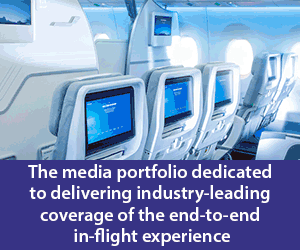Inflight editor Alexander Preston summarises the latest happenings across IFEC and cabin technology.
Well, temporarily removing trains (as so many operators seem to do) the aviation and automotive industries have long shared a crossover of designs, ideas and processes.
Back in 2016, Reg Kenney, president of the engineering and manufacturing sector at DHL, wrote about the lessons the aviation and aerospace industries could learn from the ‘cross-pollination’ of knowledge and best practice that is allowing automotive companies to achieve economies of scale and drive efficiencies by exploiting connected and integrated supply chains.
The influence of the automotive industry is, however, firmly felt in the design environment, which draws on the collaboration between multidisciplinary teams. Bombardier’s business aircraft industrial designers define the customer experience onboard using the latest in architecture and automotive design as sources of inspiration for the layout, furniture and materials that will be used.
Design consultants such as Factorydesign, Tangerine, and Design Q have teams with automotive design backgrounds; seat manufacturers like Adient, Mirus, Pitch and Recaro have automotive supply experience while BMWDesignWorks, Peugeot and Mercedes Benz (main picture) are active across both the commercial and business jet/rotor markets.
Not to mention the advent of flying cars…
As airlines invest in new, lighter aircraft made of composite materials, such as carbon fibre in the Boeing 787 Dreamliner and Airbus A350, there is still great potential to make a step-change in cabin layout, passenger comfort, fuel-saving and carbon emission reductions, compared to existing, traditional approaches, through the application of new interior design and lightweight materials.
Step forward Williams Advanced Engineering and JPA Design, who are set to showcase an example of the innovative new technology on offer to airlines and their passengers at the AIX Expo on the ADS stand, 3UA10 in the UK Pavilion, Hall B3 Upper of the Hamburg Messe.
Says James Park, founder and principal of JPA Design: “The fruits of this partnership will offer our customers better use of the space in their cabins, enhanced comfort and functionality for their passengers and a boost to airline profitability.”
As FactoryDesign’s James Tanner wrote in 2017 on the use of higher levels of material quality taken from luxury vehicles and introduced into the cabin: “Travelling can be stressful, so the aim is to ensure a seamless transition from one transport to another, making the passenger feel relaxed and at ease.”
The road ahead seems to be open for more synergies and collaboration between the aviation and automotive industries.
The editor’s comment is published weekly as an accompaniment to the Inflight e-newsletter. If you do not currently receive our email updates, you can subscribe here.






